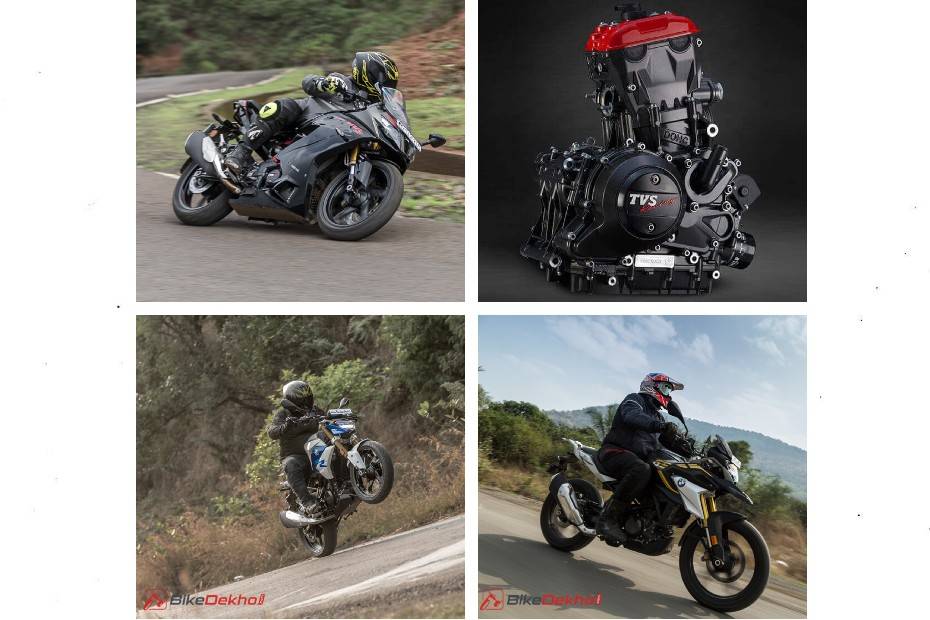TVS Apache RR 310: One Engine Different Personalities
Published On Aug 21, 2021 04:00 PM By Manaal Mahatmefor TVS Apache RR 310
- 2702 Views
A closer look at the exciting motorcycles brought to our market through this Indo-German alliance

Motorsport has always been the key ingredient in developing great motorcycles. So when BMW Motorrad and TVS Motor Company, both with credible racing experience on and off the tarmac decided to team up, the world and especially the Indian market had a lot to look forward to.
After inking the deal in 2013, the reverse-inclined 313cc liquid-cooled engine made its debut in 2015, before TVS finally put it into production in 2017. One of the most interesting aspects of this engine was the placement of the intake and exhaust ports. Unlike the conventional layout, the engine had the intake layout at the front and the exhaust port at the rear. This negates the need for unruly exhaust routing, allows for tighter packaging, and keeps the heat away from the rider’s legs. Here’s a closer look at the different applications of the same engine:
TVS Apache RR 310

For a company with a proven racing heritage, a supersport was the most logical (and exciting) application for the new engine. The TVS Apache RR 310 made its debut at the 2016 Auto Expo and hit the showrooms in 2017.
While the flagship motorcycle from the Hosur-based manufacturer looked drop-dead gorgeous, TVS hit a few hurdles. The bike was plagued with vibrations and mediocre refinement levels. However, TVS was quick to make the necessary changes, and over the course of the next three years, built a near-perfect motorcycle.
The 2020 TVS Apache RR 310 flaunted a TFT display, segment-first riding modes, an improved version of the Glide Through Traffic (GTT+) technology, and the magnificent Michelin Road 5 tyres. TVS even managed to cut the vibrations to quite an extent. But TVS isn’t done yet. The 2021 iteration of the TVS Apache RR 310 is slated to launch on August 30, and if you are keen to know what it could pack, read this story.
- Honda CBF190X Vs Honda CB200X: Photo Comparison
- Top 5 Premium Electric Scooters With Longest Warranty Periods: Bajaj Chetak, TVS iQube, Simple One And More
BMW G 310 R

The TVS-BMW merger was of strategic importance as well, since it was the German manufacturer’s ticket to enter the sub 500cc segment. A roadster was a no-brainer, given its mass-market appeal. It became an instant hit globally, and how could it not? After all, almost everyone has had aspirations to own a Beemer.
The BMW G 310 R produced 33.9PS at 9500rpm and 28Nm at 7500rpm from the liquid-cooled single-cylinder engine. Vibrations, a typical character of performance-oriented single-cylinders, was taken care of by deploying a counterbalanced crankshaft.
Just like any new product, things didn’t work in the bike’s favour. The engine sounded gruff, and vibrations could still be felt. More importantly, it was the poor pricing in our market that plummeted the sales. However, with the BS6 iteration, things have changed for the better. The manufacturer not only slashed the pricing considerably but also worked on other issues. Read our road test review to know how the BS6 BMW G 310 R fares.
BMW G 310 GS

BMW Motorrad’s GS lineup is one of the most coveted ADVs in the industry, and introducing an entry-level bike seemed like the right move. The Bavarian giant introduced the G 310 GS along with the roadster sibling, and shared important components like the frame, engine and even the 300/240mm disc setup.
Given its intended use of venturing beyond the tarmac, the BMW G 310 GS came with different bodywork, in sync with the bigger siblings, longer-travel suspension and dual-purpose tyres. Just like its sibling, the BS6 updates brought a handful of updates including ride-by-wire and adjustable levers. Wondering if the baby GS is true to its ‘GS’ moniker? Head to our road test review to find out.
